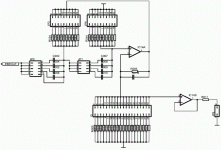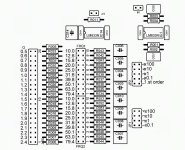Just a note about the filter and changing Q
Hi,
You problably all know this, but be sure to have a gain adjustment on the output of the filter section.
When you change the Q of a sallen and key filter by means of the qain, you also change the pass band gain.
So of gain is = 2 you must have a gain of 0.5 on the output to ensure that the following stages are not clipping.
\Jens
Hi,
You problably all know this, but be sure to have a gain adjustment on the output of the filter section.
When you change the Q of a sallen and key filter by means of the qain, you also change the pass band gain.
So of gain is = 2 you must have a gain of 0.5 on the output to ensure that the following stages are not clipping.
\Jens
Great work moamps, thanks for posting it here.
The last time I tried an active X-over I wasn't too impressed but being a discrete design with everything variable it maybe time to give it another try
I am definitely interested in getting a couple of boards (whatever many boards one needs to get a stereo two way balanced filter).
I would do the board but I don't have any time to spare right now.
Maybe we should all wait for the chinese to get it done.
The last time I tried an active X-over I wasn't too impressed but being a discrete design with everything variable it maybe time to give it another try
I am definitely interested in getting a couple of boards (whatever many boards one needs to get a stereo two way balanced filter).
I would do the board but I don't have any time to spare right now.
Maybe we should all wait for the chinese to get it done.
I'm not chinese but....
Hi,
I'll do it. I'm starting on the schmatics for one block today. when done ill post the result.
Please comment if the schematics posted already are like you want them, or if they schould be changed in any way.
Also, ill do the layout using dual opamps, so if you want a descrete opamp make a dual one that can fit in a 8 pin DIL socket.
\Jens
Hi,
I'll do it. I'm starting on the schmatics for one block today. when done ill post the result.
Please comment if the schematics posted already are like you want them, or if they schould be changed in any way.
Also, ill do the layout using dual opamps, so if you want a descrete opamp make a dual one that can fit in a 8 pin DIL socket.
\Jens
Opamps
Hi,
I feel that a Q of 1 is a bit too littel, so how about making the option og Q go from 0.5 to 2.0 in steps of 0.1?
The reason is that this gives the option of using the HP section as a low frew EQ for a sub or small speaker system.
I do not think that descrete opamps bettet are than some of the IC's you can get, if they were, opamp designers would have made them into a commeciel product many years ago.
\Jens
Hi,
I feel that a Q of 1 is a bit too littel, so how about making the option og Q go from 0.5 to 2.0 in steps of 0.1?
The reason is that this gives the option of using the HP section as a low frew EQ for a sub or small speaker system.
I do not think that descrete opamps bettet are than some of the IC's you can get, if they were, opamp designers would have made them into a commeciel product many years ago.
\Jens
Having variable Q is a good idea. I would be especially interestd to have an eq for the super-trebles above 15khz.
Understand your theory about discrete opamps, but have you actual listening experiences you can share ? Anyhow, it would be great to have the option to use discrete opamps with a stabile connection.
Understand your theory about discrete opamps, but have you actual listening experiences you can share ? Anyhow, it would be great to have the option to use discrete opamps with a stabile connection.
Hi,
I am very interested in making an active crossover but only if it is with dicrete opamps. One thing that is always missing is equalisation at different frequencies. Specially woofers have dips and peaks that have to be corrected. How do you do that? For instance my Peerless woofers have a peak +3 dB at 1,8 KHz from 800 Hz to 3KHz. I correct that passive with an LRC series network. It would be helpfull to also do this active.
I am very interested in making an active crossover but only if it is with dicrete opamps. One thing that is always missing is equalisation at different frequencies. Specially woofers have dips and peaks that have to be corrected. How do you do that? For instance my Peerless woofers have a peak +3 dB at 1,8 KHz from 800 Hz to 3KHz. I correct that passive with an LRC series network. It would be helpfull to also do this active.
Eq
Hi,
Check this dok for info on EQ and active cross overs
http://www.delta-audio.com/Active filter one.htm
\Jens
Hi,
Check this dok for info on EQ and active cross overs
http://www.delta-audio.com/Active filter one.htm
\Jens
In my opinion the use of discrete or integrated opamps has to be left to the final user, so the PCBs should be made in order to accept both.
Moamps' approach required a DIL-to-SIL adapter for the integrated opamps, if we want to avoid it a DIP socket could be placed on the "main" PCB leaving the space to mount a discrete OPAMP with a matching pinout in piggy-back.
I slightly favour the SIL approach, since it seems to simplify the overall layout.
Cheers
Andrea
Moamps' approach required a DIL-to-SIL adapter for the integrated opamps, if we want to avoid it a DIP socket could be placed on the "main" PCB leaving the space to mount a discrete OPAMP with a matching pinout in piggy-back.
I slightly favour the SIL approach, since it seems to simplify the overall layout.
Cheers
Andrea
Re: Opamps
Hi,
I don't think so.
This discrete opamp works in class A with small open loop gain. Standard IC opamps work usually in class AB or B with huge open loop gain.
Regards
JensRasmussen said:I do not think that descrete opamps bettet are than some of the IC's you can get, if they were, opamp designers would have made them into a commeciel product many years ago.
Hi,
I don't think so.
This discrete opamp works in class A with small open loop gain. Standard IC opamps work usually in class AB or B with huge open loop gain.
Regards
Hey Jens,
that´s your work.
Very good.
I am very impressed. Everything uses normal circuits but can be substituted with discrete opamps. what would be interesting would be to make the equalisation also modular. Because someone might not need it or maybe someone needs 2-3 points.
It´s just an idea.
what´s the difference between overall equalisation and equalisation after the crossover?
that´s your work.
Very good.
I am very impressed. Everything uses normal circuits but can be substituted with discrete opamps. what would be interesting would be to make the equalisation also modular. Because someone might not need it or maybe someone needs 2-3 points.
It´s just an idea.
what´s the difference between overall equalisation and equalisation after the crossover?
- Status
- This old topic is closed. If you want to reopen this topic, contact a moderator using the "Report Post" button.
- Home
- Source & Line
- Analog Line Level
- MOX - active crossover

